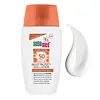What's inside
What's inside
 Key Ingredients
Key Ingredients

 Benefits
Benefits

 Concerns
Concerns

 Ingredients Side-by-side
Ingredients Side-by-side

Water
Skin ConditioningDibutyl Adipate
EmollientOctocrylene
UV AbsorberC12-15 Alkyl Benzoate
AntimicrobialGlycerin
HumectantButyl Methoxydibenzoylmethane
UV AbsorberTitanium Dioxide
Cosmetic ColorantVp/Eicosene Copolymer
Dimethicone
EmollientLauryl Glucoside
CleansingPanthenol
Skin ConditioningMicrocrystalline Cellulose
AbsorbentBis-Ethylhexyloxyphenol Methoxyphenyl Triazine
Skin ConditioningTocopheryl Acetate
AntioxidantPolyglyceryl-2 Dipolyhydroxystearate
Skin ConditioningPhenoxyethanol
PreservativeSodium Cetearyl Sulfate
CleansingBenzyl Alcohol
PerfumingDiethylhexyl Butamido Triazone
UV AbsorberCellulose Gum
Emulsion StabilisingSilica
AbrasiveParfum
MaskingSorbic Acid
PreservativeEthylhexylglycerin
Skin ConditioningDisodium EDTA
Xanthan Gum
EmulsifyingDehydroacetic Acid
PreservativeInulin
Skin ConditioningLecithin
EmollientWater, Dibutyl Adipate, Octocrylene, C12-15 Alkyl Benzoate, Glycerin, Butyl Methoxydibenzoylmethane, Titanium Dioxide, Vp/Eicosene Copolymer, Dimethicone, Lauryl Glucoside, Panthenol, Microcrystalline Cellulose, Bis-Ethylhexyloxyphenol Methoxyphenyl Triazine, Tocopheryl Acetate, Polyglyceryl-2 Dipolyhydroxystearate, Phenoxyethanol, Sodium Cetearyl Sulfate, Benzyl Alcohol, Diethylhexyl Butamido Triazone, Cellulose Gum, Silica, Parfum, Sorbic Acid, Ethylhexylglycerin, Disodium EDTA, Xanthan Gum, Dehydroacetic Acid, Inulin, Lecithin
Water
Skin ConditioningMethylene Bis-Benzotriazolyl Tetramethylbutylphenol
UV FilterPentylene Glycol
Skin ConditioningC12-15 Alkyl Benzoate
AntimicrobialCaprylyl Methicone
Skin ConditioningBis-Ethylhexyloxyphenol Methoxyphenyl Triazine
Skin ConditioningC12-16 Alcohols
EmollientHydrogenated Polyisobutene
EmollientPolysilicone-15
UV FilterDimethicone
EmollientEthylhexyl Triazone
UV AbsorberPotassium Cetyl Phosphate
EmulsifyingZinc Oxide
Cosmetic ColorantPalm Acid
CleansingHydrogenated Lecithin
EmulsifyingCaprylyl Glycol
EmollientEctoin
Skin ConditioningCannabis Sativa Seed Oil
EmollientSqualane
EmollientSodium Polyacrylate
AbsorbentBisabolol
MaskingHelianthus Annuus Seed
Skin ConditioningSilica
AbrasiveGlycine Soja Lipids
Skin ConditioningAcrylates/C10-30 Alkyl Acrylate Crosspolymer
Emulsion StabilisingAcacia Senegal Gum
MaskingHippophae Rhamnoides Acid
EmollientRosmarinus Officinalis Leaf Extract
AntimicrobialTocopherol
AntioxidantCrocus Chrysanthus Bulb Extract
Skin ConditioningWater, Methylene Bis-Benzotriazolyl Tetramethylbutylphenol, Pentylene Glycol, C12-15 Alkyl Benzoate, Caprylyl Methicone, Bis-Ethylhexyloxyphenol Methoxyphenyl Triazine, C12-16 Alcohols, Hydrogenated Polyisobutene, Polysilicone-15, Dimethicone, Ethylhexyl Triazone, Potassium Cetyl Phosphate, Zinc Oxide, Palm Acid, Hydrogenated Lecithin, Caprylyl Glycol, Ectoin, Cannabis Sativa Seed Oil, Squalane, Sodium Polyacrylate, Bisabolol, Helianthus Annuus Seed, Silica, Glycine Soja Lipids, Acrylates/C10-30 Alkyl Acrylate Crosspolymer, Acacia Senegal Gum, Hippophae Rhamnoides Acid, Rosmarinus Officinalis Leaf Extract, Tocopherol, Crocus Chrysanthus Bulb Extract
 Reviews
Reviews

Ingredients Explained
These ingredients are found in both products.
Ingredients higher up in an ingredient list are typically present in a larger amount.
You might know this ingredient as Tinosorb S or Bemotrizinol. It is a UV filter that covers both UVA and UVB rays.
This ingredient has two peak UV absorption peaks ( 310 and 340 nm) and is able to absorb both UV-A and UV-B rays. This ingredient works by preventing UV rays from reaching and damaging your skin.
On top of that - it is highly photostable and helps prevent the photodegration of other sunscreen ingredients such as avobenzone.
Tinosorb S is allowed in the EU, Australia, and Asia. It is close to being approved by the FDA and we'll hopefully get this ingredient in the U.S. by late 2025.
Fun fact: Tinosorb S is the most effective UV absorber at maximum concentration (measured by SPF) permitted in the EU.
This ingredient is oil-soluble, so your oil-cleansers will take this right off at night.
Learn more about Bis-Ethylhexyloxyphenol Methoxyphenyl TriazineC12-15 Alkyl Benzoate is made up of Benzoic Acid and long chain alcohols. It has a low molecular weight.
C12-15 Alkyl Benzoate is an emollient and texture enhancer. Due to its solubility, it is often used in sunscreens to help evenly distribute active ingredients.
As an emollient, C12-15 Alkyl Benzoate helps soften and hydrate your skin. Emollients create a film on your skin that traps moisture within.
This ingredient has been reported to cause eye irritation.
Learn more about C12-15 Alkyl BenzoateDimethicone is a type of synthetic silicone created from natural materials such as quartz.
What it does:
Dimethicone comes in different viscosities:
Depending on the viscosity, dimethicone has different properties.
Ingredients lists don't always show which type is used, so we recommend reaching out to the brand if you have questions about the viscosity.
This ingredient is unlikely to cause irritation because it does not get absorbed into skin. However, people with silicone allergies should be careful about using this ingredient.
Note: Dimethicone may contribute to pilling. This is because it is not oil or water soluble, so pilling may occur when layered with products. When mixed with heavy oils in a formula, the outcome is also quite greasy.
Learn more about DimethiconeSilica, also known as silicon dioxide, is a naturally occurring mineral. It is used as a fine, spherical, and porous powder in cosmetics.
Though it has exfoliant properties, the function of silica varies depending on the product.
The unique structure of silica enhances the spreadability and adds smoothness, making it a great texture enhancer.
It is also used as an active carrier, emulsifier, and mattifier due to its ability to absorb excess oil.
In some products, tiny microneedles called spicules are made from silica or hydrolyzed sponge. When you rub them in, they lightly polish away dead skin layers and enhance the penetration of active ingredients.
Learn more about SilicaWater. It's the most common cosmetic ingredient of all. You'll usually see it at the top of ingredient lists, meaning that it makes up the largest part of the product.
So why is it so popular? Water most often acts as a solvent - this means that it helps dissolve other ingredients into the formulation.
You'll also recognize water as that liquid we all need to stay alive. If you see this, drink a glass of water. Stay hydrated!
Learn more about Water